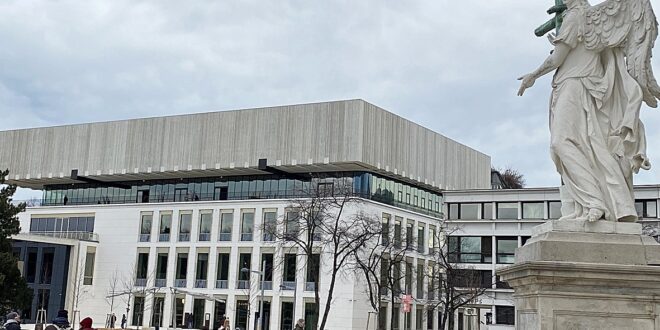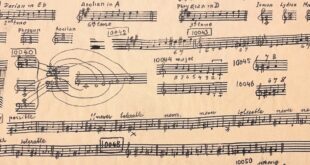April 2024 Since the Wien Museum (Vienna Museum) spectacularly transformed and almost doubled in size in 2023 it’s bound to become a new cultural magnet in town. Across three floors and 3,300 square meters, the permanent exhibition shows approximately 1,700 objects – each of which has been restored. Above the freely accessible terrace and the Trude & Daughters restaurant the new ‘floating floor’ hosts special exhibitions.
In essence, the ‘super museum’ rolls out the city’s history, from a humble settlement 8,000 years ago to today’s cultural pearl of Europe. Temporal or thematic chapters delineate each floor, and each presentation is crafted in a distinct architectural style.
Why Visit The Wien Museum?
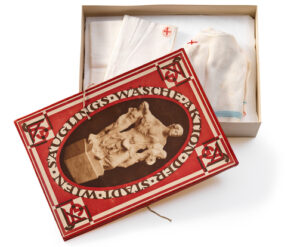 Just days after its re-opening in December 2023 I revisited Wien Museum. At historical sightseeing tours you hear a lot of local history, which the Wien Museum helps structure. In addition, the museum focusses on stories of the “ordinary” populace and the working class starting from the period of Enlightenment: a perfect complement to the Habsburg Emperors’ grand narratives told at places like Hofburg and Schönbrunn Palace.
Just days after its re-opening in December 2023 I revisited Wien Museum. At historical sightseeing tours you hear a lot of local history, which the Wien Museum helps structure. In addition, the museum focusses on stories of the “ordinary” populace and the working class starting from the period of Enlightenment: a perfect complement to the Habsburg Emperors’ grand narratives told at places like Hofburg and Schönbrunn Palace.
This picture shows an infant clothing pack by the Vienna Municipality during World War I.
What Is There To See At The Vienna Museum?
In a fascinating digital representation Vienna’s swift evolution comes to life. Once a Roman military settlement called Vindobona, Vienna lived through two Ottoman sieges. Then Wien expanded its suburban areas, created the Ringstrasse, regulated the Danube river, established a railway network, and constructed municipal buildings. All in all, this digital model vividly captures the developments that have shaped Vienna’s urban landscape.
Roman Vienna
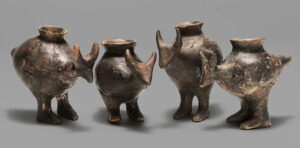 On the ground level, the initial chambers exhibit early geological discoveries alongside excavated artifacts, including jewelry and weapons dating back to 2000 BC. In fact, the collection hosts thousands of objects from pre-historic local finds: vases, urns, ceramics, and coins of prehistoric origin and of Roman Vienna; jewellery, weapons, fabrics and objects from tombs of the Migration Period, the Dark Ages and the Middle Ages.
On the ground level, the initial chambers exhibit early geological discoveries alongside excavated artifacts, including jewelry and weapons dating back to 2000 BC. In fact, the collection hosts thousands of objects from pre-historic local finds: vases, urns, ceramics, and coins of prehistoric origin and of Roman Vienna; jewellery, weapons, fabrics and objects from tombs of the Migration Period, the Dark Ages and the Middle Ages.
Vienna Highlights
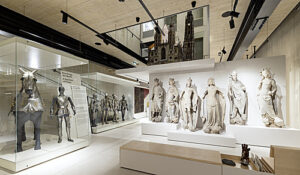 On your journey through the Middle Ages and the Renaissance a multitude of sand-lime stone sculptures depicting saints guide you. They once lived on the North tower of St. Stephen’s Cathedral. Following these sculptures and an array of knights’ armor, you will eventually peer into the expansive hall on the first floor through ceiling openings.
On your journey through the Middle Ages and the Renaissance a multitude of sand-lime stone sculptures depicting saints guide you. They once lived on the North tower of St. Stephen’s Cathedral. Following these sculptures and an array of knights’ armor, you will eventually peer into the expansive hall on the first floor through ceiling openings.
Taking a break from the earlier chronological flow, a collection of significant artifacts lines up vertically and horizontally: Notable items include an Austro-Hungarian horse-drawn carriage, an old train station lettering, and Poldi, a nine-meter-long whale originally housed in the Gasthaus Zum Walfisch in the Vienna Prater. Airlifted into the building even before its completion Poldi dominates the scene. Additionally, the original fountain sculptures from Donnerbrunnen at Neuer Markt now stretch their limbs at the museum.
Highlights Of The Biedermeier Era
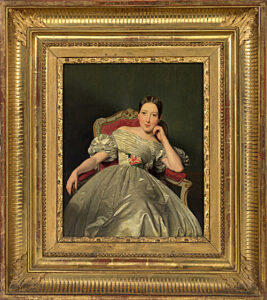 From there, the exhibition unfolds from Baroque and Enlightenment periods to Biedermeier, when Empress Sissi and Emperor Francis Joseph reigned. Within one of the most splendid halls you experience the era of the Ringstrasse construction.
From there, the exhibition unfolds from Baroque and Enlightenment periods to Biedermeier, when Empress Sissi and Emperor Francis Joseph reigned. Within one of the most splendid halls you experience the era of the Ringstrasse construction.
In a more elegant adjacent setting, various exhibits line up from an period when Vienna experienced prosperity and flourishing. Especially painters like Ferdinand Georg Waldmüller (see his painting ‘sitting girl’), Hans Makart, Franz Schrotzberg and Tina Blau tell visual stories of their times. But also the fully furnished room of Austrian playwright Franz Grillparzer and everyday items such as clothing contribute to the narrative.
Vienna In The 20th And 21st Century
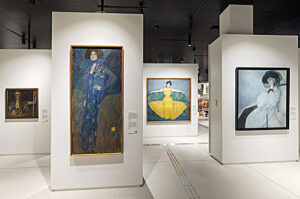 What follows is an intricate exploration of Vienna circa 1900. Most importantly for art fans, works of geniuses Gustav Klimt, Josef Hofmann and Koloman Moser showcase the Wiener Jugendstil (Art Nouveau). In particular, watch out for Gustav Klimt’s Emilie Flöge and Pallas Athene. The subsequent era of Modernism is best represented by the works of Egon Schiele,.
What follows is an intricate exploration of Vienna circa 1900. Most importantly for art fans, works of geniuses Gustav Klimt, Josef Hofmann and Koloman Moser showcase the Wiener Jugendstil (Art Nouveau). In particular, watch out for Gustav Klimt’s Emilie Flöge and Pallas Athene. The subsequent era of Modernism is best represented by the works of Egon Schiele,.
Rather abruptly you enter the era of the First World War and Red Vienna: a dense array of posters, objects, videos, blackboards, and sculptures crowds a limited space. This swift pace persists as the exhibition delves into the detailed and reflective chapter on the Second World War. Countless stories of Jewish residents who had to escape the Nazi terror or were murdered both move and shock.
Finishing off, the permanent collection also captures several contemporary events, such as placards commemorating the initial stage of the “Fridays for Future” protests in 2018/19 and photographic works by Klaus Pichler, portraying the temporary memorial site for the 2020 terrorist attack in the heart of Vienna. As part of the focus on present-day topics, including migration, the environment, and social issues you can hear various voices from local residents.
How Much Time Do You Need To Visit The Vienna Museum?
If you want to view the Vienna Museum’s permanent exhibition quickly and still have enough time to go into details, you should allow two to three hours.
Vienna Museum: Practical Information
Location: Karlsplatz 8; 1010 Wien;
Opening Hours: Tuesday to Friday, 09:00-18:00, Saturday and Sunday, 10:00-18:00; 24th and 31st December from 10 amto2 pm. Closed on Mondays and on New Year’s Day, 1st May and Christmas Day.
Tickets: free entry to the permanent exhibition
Public transportation: Underground U1, U2, U4 (Karlsplatz stop), U3 to Stephansplatz;Trams: 1, 2, D, 62, 65.
Other great Vienna museums: Belvedere Vienna, Albertina Vienna, House of Music, Hapsburgs Museum of Furniture (Hofmobiliendepot)
learn more about Vienna Museums
visit What To Do In Vienna
back to Vienna Unwrapped homepage
